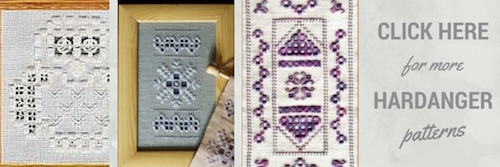- Home
- Lesson 4
Free Hardanger Instructions - Lesson 4
We have covered Hardanger instructions for Kloster blocks, needleweaving and dove's eyes in the previous pages of this Hardanger course.
Now it's time to introduce four-sided stitch and a spider's web filling.
You can access the other lessons by clicking on this link.
Before you follow the Hardanger instructions below, you need to...
Please respect my copyright on this chart and print a copy for yourself, but do not give it away or sell it on to anyone else.
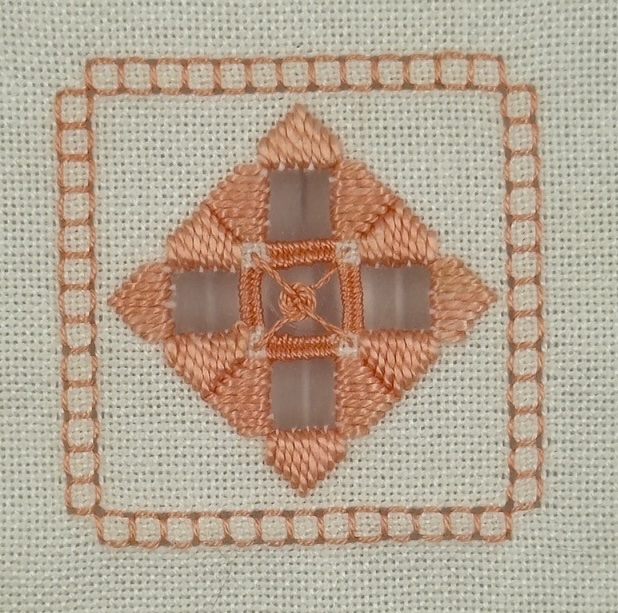 Completed design worked in peach pearl cotton
Completed design worked in peach pearl cottonYou will need
- Hardanger 22count fabric (approx 5" square)
- Pearl no. 5 and 8
- tapestry needles size 20 and 24
- sharp, pointed scissors
- wooden embroidery hoop
Hardanger instructions - Kloster blocks
Start by finding the centre of your fabric by folding it in half both ways. From that centre point, count up 16 threads and left 4 threads. This is point 1 on your chart (the one which is above the big letter C) and where we are going to start.
Thread a longish piece of the thicker perle 5 into your needle. You can use an away waste knot to secure the end.
Bring the needle up at point 1 and take it back down over 4 fabric threads at point two above. Bring it back up at point 3 (next to 1) and this time make the stitch slightly longer, over 5 fabric threads.
Continue in the same manner, making the next three stitches. Then start reducing the length of each stitch again to complete the shaped Kloster block.
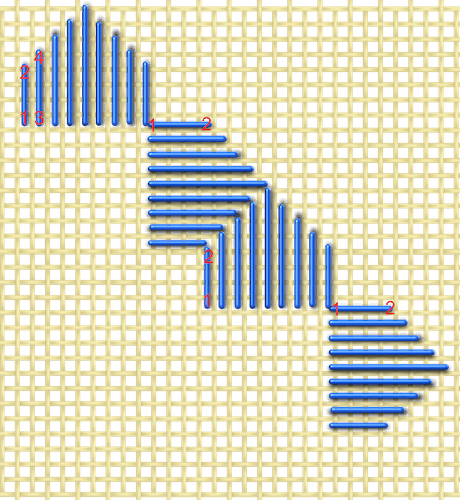 Diagram for the kloster blocks
Diagram for the kloster blocksTo begin the second block, bring the needle back up in the same hole you used at the bottom of the last stitch. I have numbered this 1 again on the diagram (above the big letter A). This avoids creating a stitch that lies diagonally across the back of the work.
Stitch the second block as before, making sure you carry the thread behind the block on the back. If you only take a tiny stitch from one top point to the next your work will not hold together once you cut.
Continue working the Kloster blocks re-using the corner holes as before.
Again, avoid diagonal stitches when you start a new block. If these diagonal stitches fall across an area that you will later cut they will become a nuisance and visible in the final work.
The diagram above shows the placement of the first four Kloster blocks.
Four-Sided stitch
Our next step is to work the border around our design. Click the link for instructions for four-sided stitch.
Cutting the fabric threads
Once the four-sided stitch is complete, it is time to cut and remove the threads for the openwork area. Only cut where marked with red lines on the chart.
Use a sharp, fine pointed pair of scissors and count carefully before you cut.
You can use your needle to create a "channel" for the scissors. Just pop the needle into the hole used by the first stitch in the Kloster block and out again in the last. Gently pull towards the centre to open up a small gap in which to insert the scissor blades.
Each red line on the chart denotes 8 threads to be cut, but I recommend doing this in two cuts of four threads each. Keep the scissors close to the Kloster blocks, but be careful not to cut the stitches.
Carefully withdraw the fabric threads, using a pair of tweezers if it helps.
The diagram below shows the fabric threads that will remain (in this quadrant of the design). Again, I have marked where you will cut the threads with red lines.
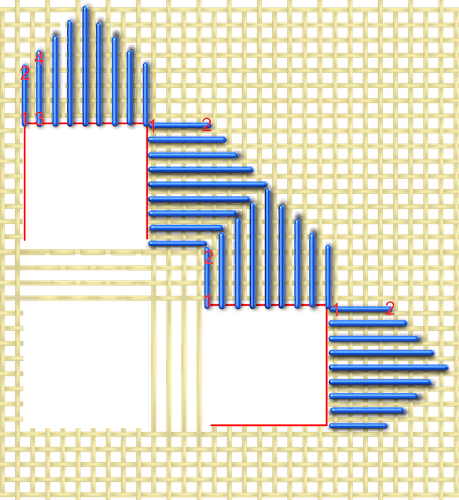 The red lines indicate where to cut the threads
The red lines indicate where to cut the threadsHardanger Instructions - Needleweaving
Using the finer perle 8 thread, needleweave the three bars shown in the diagram below, following the direction of the arrows.
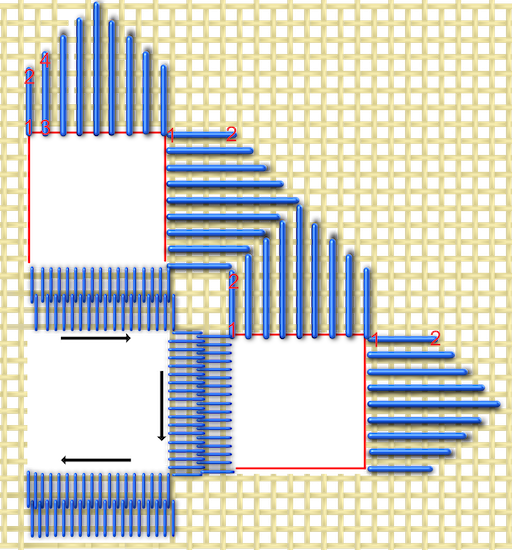 Diagram for woven bars
Diagram for woven barsWeave the four exposed threads of each bar in a figure of eight motion, taking the needle over two then under two threads. Pull the stitches firmly and work enough to fill the bar comfortably, without packing in so many that it bends out of shape.
Please note that when you actually do the needleweaving, the threads will pull close together and not remain in their original position. This is difficult to represent in a digital illustration, however, the photo further down the page shows the finished effect better.
Hardanger Instructions - Spider's Web
First, I will provide a diagram which shows the steps for you to follow. We will then continue with written Hardanger instructions and step-by-step photos, which will show how the spider's web stitch will actually look.
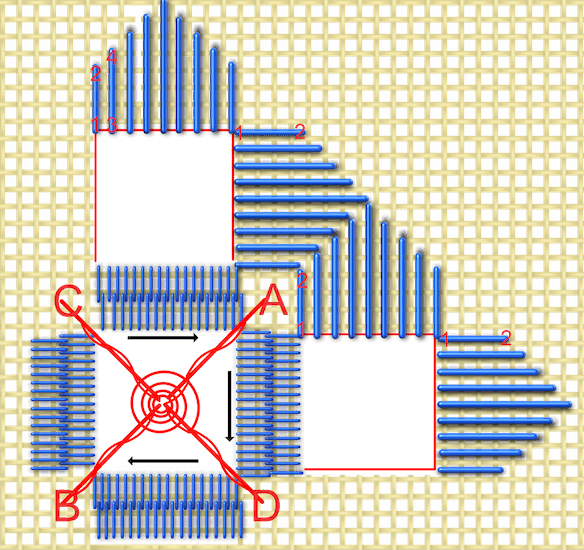 Diagram for spiders web
Diagram for spiders webThread your needle with perle 8. Secure the thread behind the Kloster blocks, then bring it up at point A on the diagram above, which is the centre hole in that little square of bare fabric. Take the thread across the centre hole and go down at B. Bring it through inside the hole in the fabric and then wrap around this thrown thread four times. Re-insert the needle at point A from the front of the work and wrap again down to B.
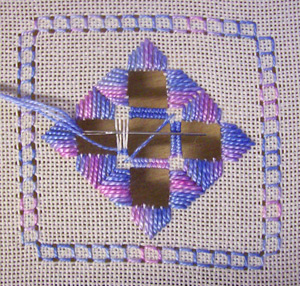 Laying the framework for the spiders web
Laying the framework for the spiders webContinue by needleweaving the fourth bar, from point B to point C on the diagram, to bring your thread to the opposite corner from the thrown thread.
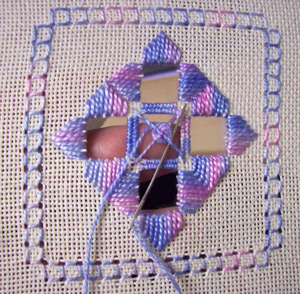 Working the spiders web in the centre of the hardanger coaster
Working the spiders web in the centre of the hardanger coasterCarry a second diagonal thread across from C to D. Take this over the top of the existing thread.
Bring the needle up from behind the work at D. Twist around this bar twice then pass the needle under both threads at the intersection in the middle.
Weave under-then-over alternate bars to form a spiral spider's web at the centre. Try to keep this flat and smooth.
When your web is the size you require, finish your stitching next to the thrown thread leading to C. Wrap this thread twice, then reinsert the needle at point C. Fasten off through the back of the Kloster blocks.
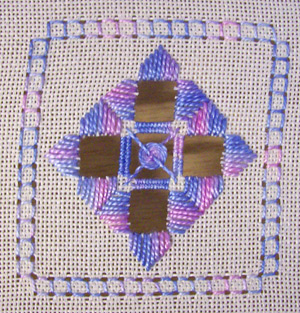 The finished coaster
The finished coasterMoving on
I hope you are finding this series of lessons helpful. If there is any point in the Hardanger instructions where you get stuck just let me know.
Stay connected between projects
If you’d like occasional updates from my embroidery room, including new patterns, gentle tips, and little things I think you might enjoy, you’re warmly invited to join the Stitchin’ Times newsletter.
No pressure. Just a friendly note now and then to keep you inspired.
